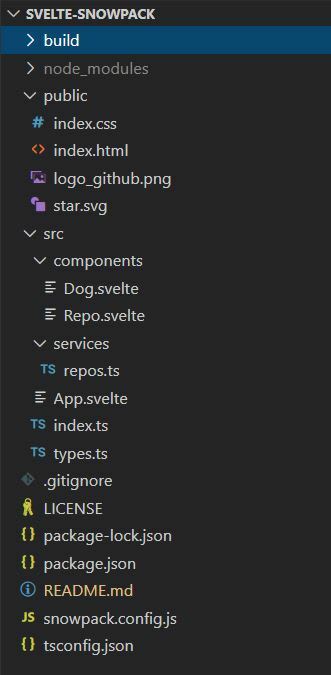I wanted to try svelte by myself to take a clearer idea of the framework. In my daily life, I work especially with react (Next.js). Both of react and svelte are based on component-architecture, the major difference is that svelte compiles the code, while react uses the virtual DOM.
What is the application?
A simple web-application that fetches the trending git repositories of a programming language and displays them.
Tools we're going to use:
The source code is available here.
The Demo.
Project architecture
the project architecture is very simple.
Let's begin
In the "src" folder we create App.svelte, it's the principal component.
const getReposByLang = async () => {
if (!reposMap.has(repoLang)) page = 0;
isSearching = true;
if (reposMap.has(repoLang) && !page === 0) {
isSearching = false;
return;
}
await getRepos(repoLang, page).then((res) => {
if (reposMap.has(repoLang)) {
reposMap.set(repoLang, [...reposMap.get(repoLang), ...res.items]);
} else reposMap.set(repoLang, res.items);
isSearching = false;
});
listRepo = reposMap.get(repoLang);
if (page === 0) page = 1;
};
// actions to do when the component is mounted first time
onMount(() => {
getReposByLang();
repoLangInput.focus();
});
The onMount function executes the getReposByLang(); and repoLangInput.focus(); when the component is mounted, it's equivalent in react is useEffect().
The getReposByLang function will fetch the repos and save them in a Map.
export default async function getRepos(repoLang: string, page: number) {
repoLang = repoLang.replace(/\s/g, "");
const response = await fetch(
`https://api.github.com/search/repositories?q=language:${repoLang}&sort=stars&order=desc&per_page=30&page=${
page + 1
}`
);
if (response.ok) {
return response.json();
} else throw new Error();
}
Displaying the git repos
{#if isSearching}
<div style="display:flex;flex-direction:row;position:relative;left:42%">
<Spinner class="spinner-border text-warning" />
</div>
{/if}
<Row>
{#each listRepo ?? [] as repo}
<Col class="mt-1 col-md-6 col-12 col-s-6 col-sm-6 col-lg-4 col-xl-3">
<Repo {repo} />
</Col>
{/each}
</Row>
We loop over listRepo which contains the git repos and display them in a grid.
We use another component to display each repo.
<Repo {repo} />
Repo is a component that has a props repo.
<script lang="ts">
import type { IRepoProps } from "src/types";
import { Card, CardBody } from "sveltestrap";
export let repo: IRepoProps;
</script>
To create props for a component we just add export to the variable name.
export let repo: IRepoProps;
Building with snowPack
I've used Snowpack to build the project; Snowpack is a lightweight alternative to webpack.
In the config file we just need to add the svelte plugin and let place to magic.
/** @type {import("snowpack").SnowpackUserConfig } */
module.exports = {
mount: {
public: "/",
src: "/dist",
},
plugins: ["@snowpack/plugin-svelte"],
routes: [
/* Enable an SPA Fallback in development: */
// {"match": "routes", "src": ".*", "dest": "/index.html"},
],
To build the project we launch snowpack build
Deploying on vercel
Deploying in vercel is very simple, we just need to import the project from Github and vercel will do all the rest.
The source code and the demo.
The source code is available here.
The Demo.
What is the application?
A simple web-application that fetches the trending git repositories of a programming language and displays them.
Tools we're going to use:
- [Svelte] (https://svelte.dev/) for developing the app.
- [SnowPack] (https://www.snowpack.dev/) for building the app.
- [Vercel] (https://vercel.com/) for deploying the app.
Project architecture
the project architecture is very simple
Let's begin
In the "src" folder we create App.svelte, it's the principal component.
const getReposByLang = async () => {
if (!reposMap.has(repoLang)) page = 0;
isSearching = true;
if (reposMap.has(repoLang) && !page === 0) {
isSearching = false;
return;
}
await getRepos(repoLang, page).then((res) => {
if (reposMap.has(repoLang)) {
reposMap.set(…
The Demo.
conclusion
Svelte is really simple to learn comparing with React, the absence of JSX, and the new paradigms brought by React make svelte the friend of the beginners in web dev. I wait for the svelte-kit which will bring more exciting features.







Top comments (2)
Nice content Kaidi!
Can you make a short course about Svelte and Typescript.
I've been looking forward to Svelte + Typescript contents for a while now
Thanks, you can check this svelte.dev/blog/svelte-and-typescript
There is all what you need to begin developing svelte with typescript , contact me if u have questions